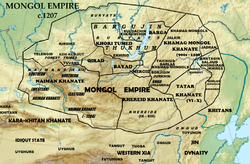Khamag Mongol
Khamag Mongol Хамаг Монголын ханлиг | |||||||||||
|---|---|---|---|---|---|---|---|---|---|---|---|
| 10th century–1206 | |||||||||||
 Mongol Empire c.1207 | |||||||||||
| Status | Khanate | ||||||||||
| Capital | Centered camp near Kherlen River | ||||||||||
| Common languages | Middle Mongol | ||||||||||
| Religion | Tengrism (Shamanism) | ||||||||||
| Government | Elective monarchy | ||||||||||
| Khan | |||||||||||
• 10th century | Khaidu | ||||||||||
• 1120–1148 | Khabul Khan (1st recorded khan) | ||||||||||
• 1148–1156 | Ambaghai Khan (2nd) | ||||||||||
• 1156–1160 | Hotula Khan (3rd) | ||||||||||
• 1189–1206 | Genghis Khan (last) | ||||||||||
| Legislature | Kurultai | ||||||||||
| Historical era | High Middle Ages | ||||||||||
• Established | 10th century | ||||||||||
• First Khan recorded in history is Khabul Khan. | 1130 | ||||||||||
• Temujin become Khagan of the Khamag and given honorary name of Genghis Khan. | 1189 | ||||||||||
• Genghis Khan unified the tribes and established the Mongol Empire. | 1206 | ||||||||||
| |||||||||||
| Today part of | |||||||||||
| History of Mongolia |
|---|
 |
Khamag Mongol (Template:Lang-mn, lit. "Whole Mongol") was a major Mongolic tribal confederation (khanlig) on the Mongolian Plateau in the 12th century. It is sometimes also considered a predecessor state[1] to the Mongol Empire.[2]
Existence of a somewhat mysterious tribal power known in Mongol tradition as Khamag Mongol Uls recorded in sources of Khitan Liao dynasty (907-1125) in North China and eastern Mongolia.[3] After the fall of Liao dynasty in 1125, the Khamag Mongols began to play an important role on the Mongolian plains.[4] They occupied one of the most fertile lands of the country, the basins of the river Onon, Kherlen and Tuul Rivers in the Khentii Mountains. The Taichiud (Cyrillic: Тайчууд) was one of the three core tribes in the Khamag Mongol Khanate of Mongolia during the 12th century and whose people lived in the southern part of Russian Zabaykalsky Krai. Zabaykalsky Krai and the Mongolian Khentii Province were core regions of the Khamag Mongol Khanate.[5] The Khamags consisted of the four core clans Khiyad, Taichuud, Jalairs and Jirukhen.
The first khan of Khamag Mongol recorded in history is Khabul Khan from the Borjigin clan. Khabul Khan successfully repelled the invasions of the Jurchen Jin armies. Khabul Khan was succeeded by Ambaghai Khagann of the Taichiud. Ambagai was captured by the Tatar confederation while delivering his daughter for marriage to their leadership. He was handed over to the Jin, who cruelly executed him. Ambaghai was succeeded by Hotula Khan, a son of Khabul Khan. Hotula Khan engaged the Tatars in 13 battles in an effort to obtain vengeance for the death of Ambagai Khan.
Khamag Mongol was unable to elect a khan after Hotula died. However, Khabul's grandson Yesugei, who was a chief of the Khiyad tribe, was an effective and preeminent leader of Khamag Mongol. Temujin, the future Genghis Khan, was born into Yesukhei's family as the first son in Delüün Boldog on the upper reaches of the Onon river in 1162.
When young Tooril Khan asked for help from Yesukhei, the ruler of the Khamag Mongol,[6] to dethrone his brothers among the Keraites, the Mongols helped him defeat the Keraite leaders and put him on the throne in the early 12th century.
Yesukhei was poisoned by the Tatars in 1170 and shortly after Yesukhei died. The Khamag Mongol began to disintegrate after Yesugei's death in 1171. Political anarchy and a power vacuum lasted until 1189 when Temujin became the Khan of the Khamag Mongol. War broke soon out between other Mongol tribes. Temujin's friend Jamukha was recognized by the rival tribes as Gur-Khan (the universal ruler) in 1201 but he was defeated by the alliance of Khamag Mongol and Keraites.
When Tooril Khan refused to cement the alliance with the Khamag, Temujin's wars with the clans nearly destroyed him. Temujin united all clans on the Mongolian plateau at last in 1206, when he was given the title Genghis Khan.
See also
Notes
- ^ Bat-Ocher Bold (2001), Mongolian nomadic society: a reconstruction of the "medieval" history of Mongolia, Richmond, Surrey: Curzon, p. 176, ISBN 0-7007-1158-9
- ^ History of the Mongolian People's Republic By Akademii︠a︡ nauk SSSR, p.99
- ^ Khamag Mongol Uls
- ^ Histoire de la Mongolie By László Lőrincz, p.43
- ^ History of Mongolia, Volume II, 2003
- ^ He never assumed the title the Khan of the Khamag Mongol but baghatur (hero)
References
- Akademiiya nauk SSSR - History of the Mongolian People's Republic, Nauka Pub. House, Central Dept. of Oriental Literature, 1973
- Bat-Ochir Bold - Mongolian Nomadic Society, St. Martin's Press, 1999. ISBN 0-312-22827-9
- The New Encyclopædia Britannica, Encyclopædia Britannica, 1974: Macropaedia Me-Ne ISBN 0-85229-290-2
- László Lőrincz - Histoire de la Mongolie, Akadémiai Kiadó,the University of Michigan, 1984. ISBN 963-05-3381-2
